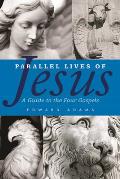When it comes to introductions to the Gospels, what comes to mind? Blomberg? Stanton? If you think about it, there isn’t a whole lot that professors have found eminently helpful for classroom use. I like Mark Allan Powell’s Fortress Introduction to the Gospels, but it is beginning to feel a bit old.
You really don’t want anything too exhaustive, as it will bog the students down in critical literature and limit interaction directly with the text. I would commend to you Eddie Adams’ new Parallel Lives of Jesus: A Guide to the Four Gospels (WJK, 2011). Adams, known for his work on Paul, has taught a gospels module a number of times and, feeling the need for a succinct introductory volume, took the step to write one himself! Something many of us consider doing!

Eddie has been much influenced by his colleague Richard Burridge and is persuaded (as am I) that the Gospels fit into the basic category of ancient biography called Lives -hence the title of the book. The four gospels are united by the desire to tell the story of Jesus. Each one, as a narrative, looks at Jesus from a different perspective. They are “parallel lives of Jesus.”
What this means in terms of an introduction to the Gospels is that Adams prioritizes a narrative reading. In the two introductory chapters he gives a simple overview of how scholars have approached the gospels, and then goes into a discussion of narrative criticism. He discusses
-narrative voice and viewpoint
-plot
-textual structure
-Style
-Narrative techniques (flashback, flash-forward, foreshadowing, inclusio, intercalation, irony, intertextuality)
-Narrative time
-Narrative space
-Themes
Adams also addresses events, characters, and settings.
In four more chapters, Adams works through each Gospel from a basic narrative perspective, showing how each Evangelist constructed his story, and which themes are developed. The last six chapters briefly compare six events in the life of Jesus by setting the four gospels side-by-side: the baptism of Jesus, the feeding of the 5k, the walking on the water, the transfiguration, the death of Jesus, and the empty tomb.
It is important to underscore the fact that Adams intention is not to study the redaction of the texts (i.e., who copied and expanded upon or modified whom), but how the stories overlap and diverge as stories with plots, styles, and themes. Adams does a great job of providing the pericopae in side-by-side comparison, and his discussions are short, but insightful.
It is fitting to finish with the summary statement of Adams: “The four Gospels…present us with a singular Jesus multiply rendered. The singularity of Jesus is not compromised by the multiple characterizations but enhanced by them” (p. 189).
Weaknesses? Not really. Perhaps there is the lingering question – how should this be used in class? I think assignments built into the book would have well-served its pedagogical purpose. Perhaps he could have given a couple of models for parallel-narrative comparison, and then offered a series of assignments for further study, supplying the Gospel texts in parallel alignment and then encouraging examination. That is not really a weakness, just a thought! Thanks Eddie!











